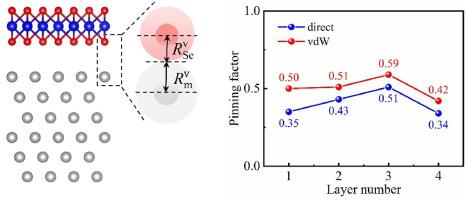Van der Waals contacts and layer-dependent Fermi level pinning at WSe2/metal interfaces
IF 8.2
2区 材料科学
Q1 MATERIALS SCIENCE, MULTIDISCIPLINARY
引用次数: 0
Abstract
Strong Fermi level pinning (FLP) at the interface between WSe2 and metal electrodes can give rise to high Schottky barriers, which would degrade the performance of electronic device. Therefore, the weak FLP is desirable as it allows decreasing Schottky barrier height (SBH) and achieving the low contact resistance. Herein, we demonstrate that the van der Waals (vdW) contacts between WSe2 and metals can greatly weaken the FLP and affect SBH. As compared to the direct contacts, the fewer metal-induced gap states and smaller interface dipoles are observed in WSe2/metal vdW contacts, which leads to the reduced FLP effect. In addition, we found that the FLP strength is also dependent on the number of WSe2 layers. Furthermore, we analyze the origin of the pinning factor deviation from Schottky-Mott limit in the WSe2/metal vdW contacts and find that the deviation originates from the interface potential difference and Fermi-level shift. Benefiting from the weak FLP, the low n-type and p-type Schottky and Ohmic contacts can be obtained in the WSe2/metal vdW contacts by choosing metal electrodes and number of WSe2 layers. These findings illustrate that creating vdW contacts can be an effective approach for developing high performance ambipolar WSe2-based electronic devices.

WSe2/金属界面上的范德华接触和依赖于层的费米能级钉钉
WSe2与金属电极界面处的强费米能级钉钉(FLP)会产生高肖特基势垒,从而降低电子器件的性能。因此,弱FLP是理想的,因为它允许降低肖特基势垒高度(SBH)并实现低接触电阻。在此,我们证明了WSe2和金属之间的范德瓦尔斯(vdW)接触可以极大地削弱FLP并影响SBH。与直接接触相比,在WSe2/金属vdW接触中观察到较少的金属诱导间隙状态和较小的界面偶极子,这导致FLP效应降低。此外,我们发现FLP强度也依赖于WSe2层数。进一步分析了WSe2/金属vdW接触中钉住因子偏离Schottky-Mott极限的原因,发现其偏离源于界面电位差和费米能级位移。利用弱FLP,通过选择金属电极和WSe2层数可以获得低n型和p型肖特基和欧姆触点。这些发现表明,创建vdW触点可以是开发高性能双极性wse2电子器件的有效方法。
本文章由计算机程序翻译,如有差异,请以英文原文为准。
求助全文
约1分钟内获得全文
求助全文
来源期刊

Materials Today Nano
Multiple-
CiteScore
11.30
自引率
3.90%
发文量
130
审稿时长
31 days
期刊介绍:
Materials Today Nano is a multidisciplinary journal dedicated to nanoscience and nanotechnology. The journal aims to showcase the latest advances in nanoscience and provide a platform for discussing new concepts and applications. With rigorous peer review, rapid decisions, and high visibility, Materials Today Nano offers authors the opportunity to publish comprehensive articles, short communications, and reviews on a wide range of topics in nanoscience. The editors welcome comprehensive articles, short communications and reviews on topics including but not limited to:
Nanoscale synthesis and assembly
Nanoscale characterization
Nanoscale fabrication
Nanoelectronics and molecular electronics
Nanomedicine
Nanomechanics
Nanosensors
Nanophotonics
Nanocomposites
 求助内容:
求助内容: 应助结果提醒方式:
应助结果提醒方式:


